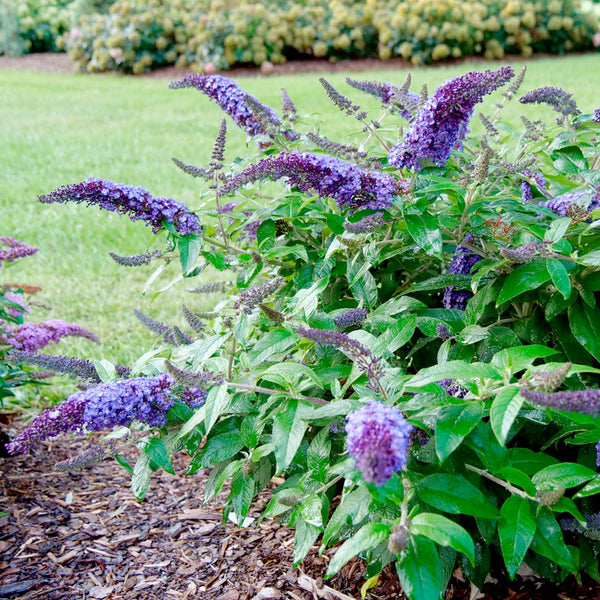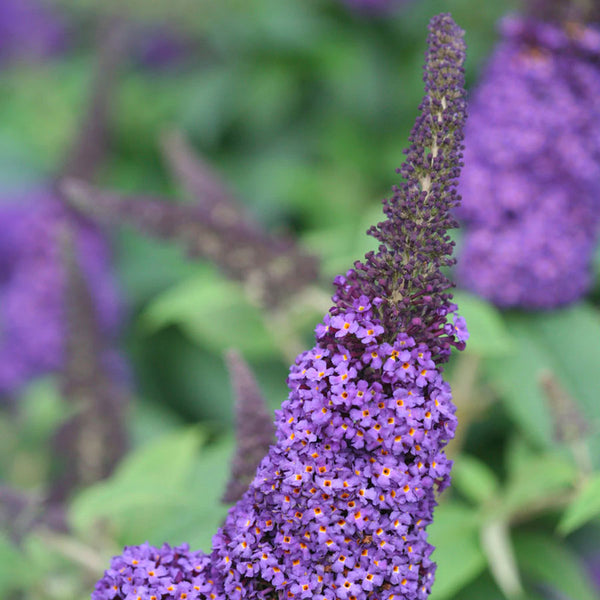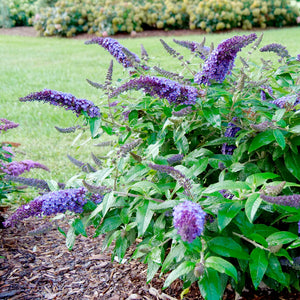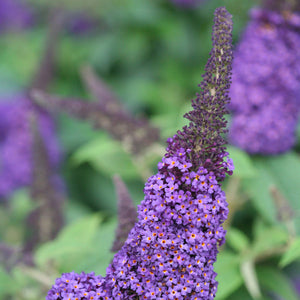Pugster Blue Butterfly Bush
Pugster Blue Butterfly Bush
This appealing dwarf bush is perfect for drawing butterflies into the garden.
- The Pugster Blue Butterfly Bush is ideal for small gardens and containers.
- It thrives in full direct sunlight.
- The true-blue flowers pair well with plants like milkweed, goldenrod, zinnias, and asters.
- Continuously blooms from early summer to first frost.


Product Details
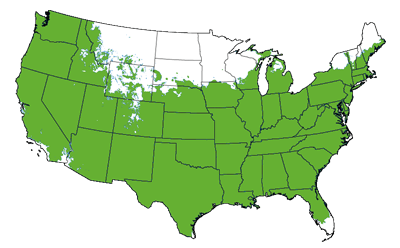 Growing Zones 5-9
Growing Zones 5-9
| Soil Type | Adaptable, Well Drained |
| Sunlight | Full |
| Drought Tolerance | |
| Mature Height | 2-3 Feet |
| Mature Width | 2-3 Feet |
| Growth Rate | Fast |
| Bloom Color | Blue |
| Shipping Restriction | AZ, OR, WA |
The exquisite blue flowers on this bush add a unique one-of-a-kind color to any size garden or landscape. The thick sturdy stems ensure winter hardiness in the colder climate zones.
At only 2 feet tall and 2 to 3 feet wide at maturity this shrub is an ideal candidate for any size yard. This winter hardy plant grows best in zones 5-9.
Should the Pugster Blue Butterfly Bush be cut back on a yearly basis?
Butterfly bushes only need to be pruned when they have outgrown the space that they are in. However butterfly bushes only bloom on new growth so many gardeners heavily prune them each spring to develop new growth which will produce lots of flowers.
Do butterfly bushes come back every year?
This dwarf butterfly bush will die every winter, then in the spring new growth will be sent out from the root system.
Is the butterfly bush the same thing as a butterfly weed?
No, actually the term butterfly weed refers to the milkweed plant that caterpillars feed on prior to their transformation into butterflies.
Are butterfly bushes actually bad for butterflies?
The butterfly bush flowers are high in nectar which is what butterflies feast on, however they are not a crucial food source for caterpillars and therefore should be accompanied by a wide variety of other plants that bloom in various intervals to create an environment that is inclusive of all the stages in a butterfly life cycle.
Simplistic Care That Produces Magnificent Beauty
These tiny but mighty shrubs enjoy soaking up the sun. In fact, they need between 6 to 8 hours of direct sunlight daily. Similar to many other plants, these beauties hate soggy soil. Pugster Blue Butterfly Bushes grow well in zones 5-9. They can be grown in planters or as a stationary part of the landscape.
Planting
With a high sensitivity to root rot, it is imperative that this ground cover is positioned so that the base of the plant is just slightly higher than the ground. The root ball should be planted directly into the ground. There should never be anything added to the ground soil at the time of planting. A spacing of 36” center to center is required to give ample room to grow.
Ideal growing zones include the majority of the east coast, the southern midwest, the west coast, and the extremely southern part of Alaska. Northern states, the southern tip of Florida and Hawaii are not suitable growing conditions for these nectar-rich flowers. These fast growing border flora should be planted in spring to allow ample time for adjustment to the climate before winter.
Watering
Moderate watering is required to maintain the picturesque beauty of the Pugster Blue Butterfly Bush. Generally watering on a weekly basis is sufficient, however during extremely hot periods, or if this dwarf plant is in a container, the watering frequency should increase so that the soil doesn’t become too dry.
Fertilizing
No additional additives are needed unless you are utilizing this cottage-style shrub in a container. If using a container, a lightweight well-draining potting mix should be used.
Maintenance
These large, dense, yet compact plants will benefit from a spring pruning. You should wait until the new green bud growth is present and prune just above where the new healthy leaf buds have formed. As a late bloomer, it is not uncommon for these showy dwarf butterfly bushes to start blooming in late June.


